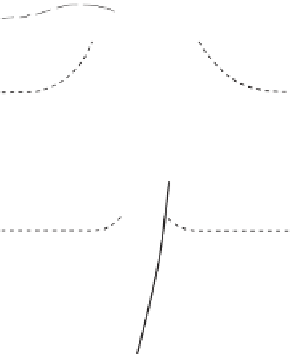Geoscience Reference
In-Depth Information
(a)
(b)
Frozen
Thawed
Active layer
Open
crack
Ice
Permafrost
1st Winter
1st Autumn
0
5
metres
(c)
(d)
Active layer
Frozen
Thawed
Open
crack
Ice
Permafrost
500th Winter
500th Autumn
Source: After Lachenbruch (1963)
have a characteristic porous, granular soil structure,
whereas the subsoils are denser and massive. The combi-
nation of summer drying and winter cryogenic activities
gives the granular structure at the surface. In the autumn
subsoils lose water to a freezing front at the surface and a
freezing front at the permafrost below; they are under
considerable cryostatic pressure between the two freezing
fronts. As a result of the desiccation and cryostatic
pressure, dense and massive subsoil structures develop
Earth hummocks are formed when cryogenic processes
are only periodically active. Higher than normal temper-
atures and rainfall in summer will combine to produce a
deeper active layer with greater moisture content, and thus
much frost heaving. Earth hummocks are common in the
western Arctic of Canada, where they appear to have been
relatively inactive in the past few decades. Activity can be
monitored by the ring structure of any trees growing on
the hummocks. The fact that in the Mackenzie valley of
Canada hummocks are now in a dormant period is also












































































































































































































































































































































































































































































































































































































































































































































































































































































































































































































































































































































































































































































































































































































































































































































































































































































































